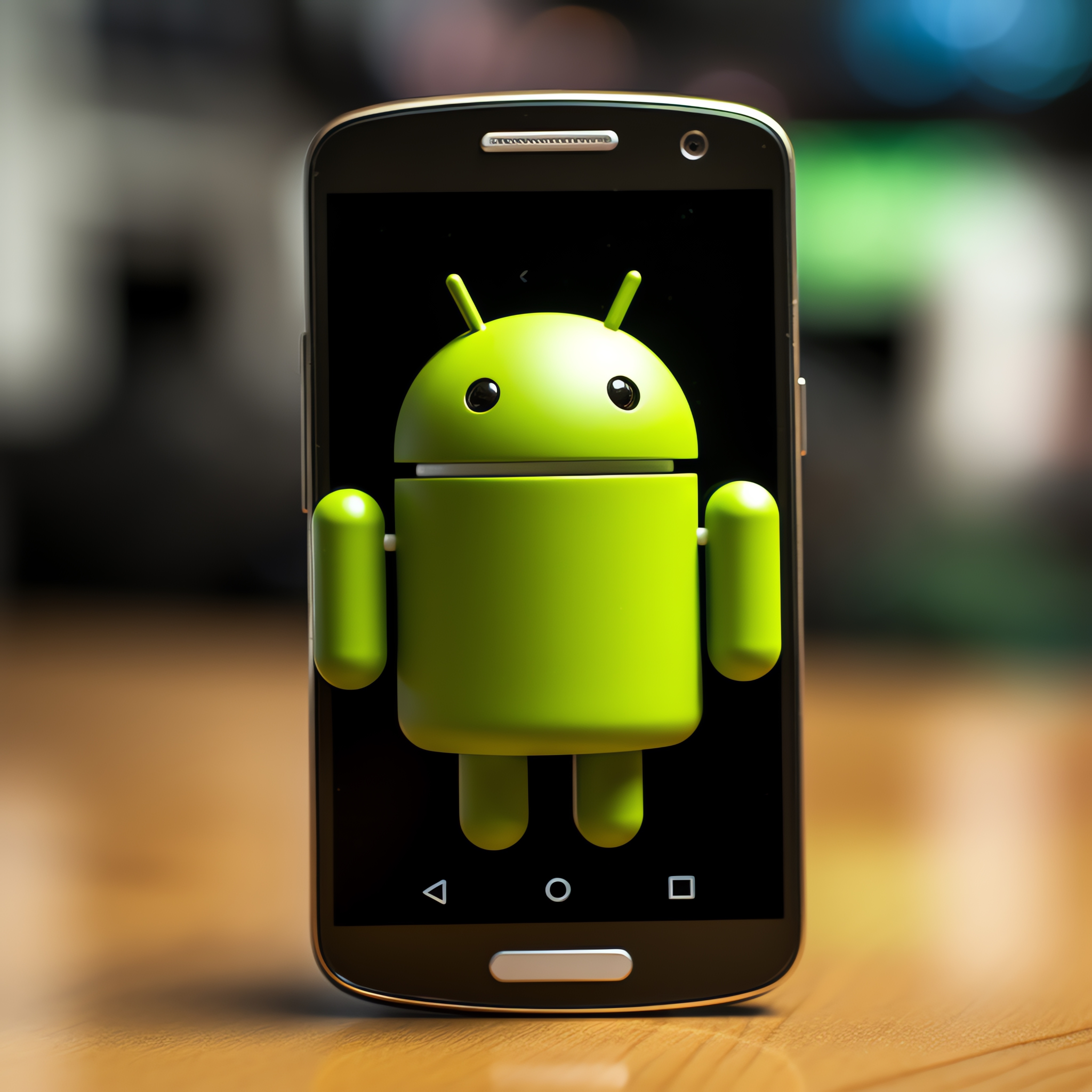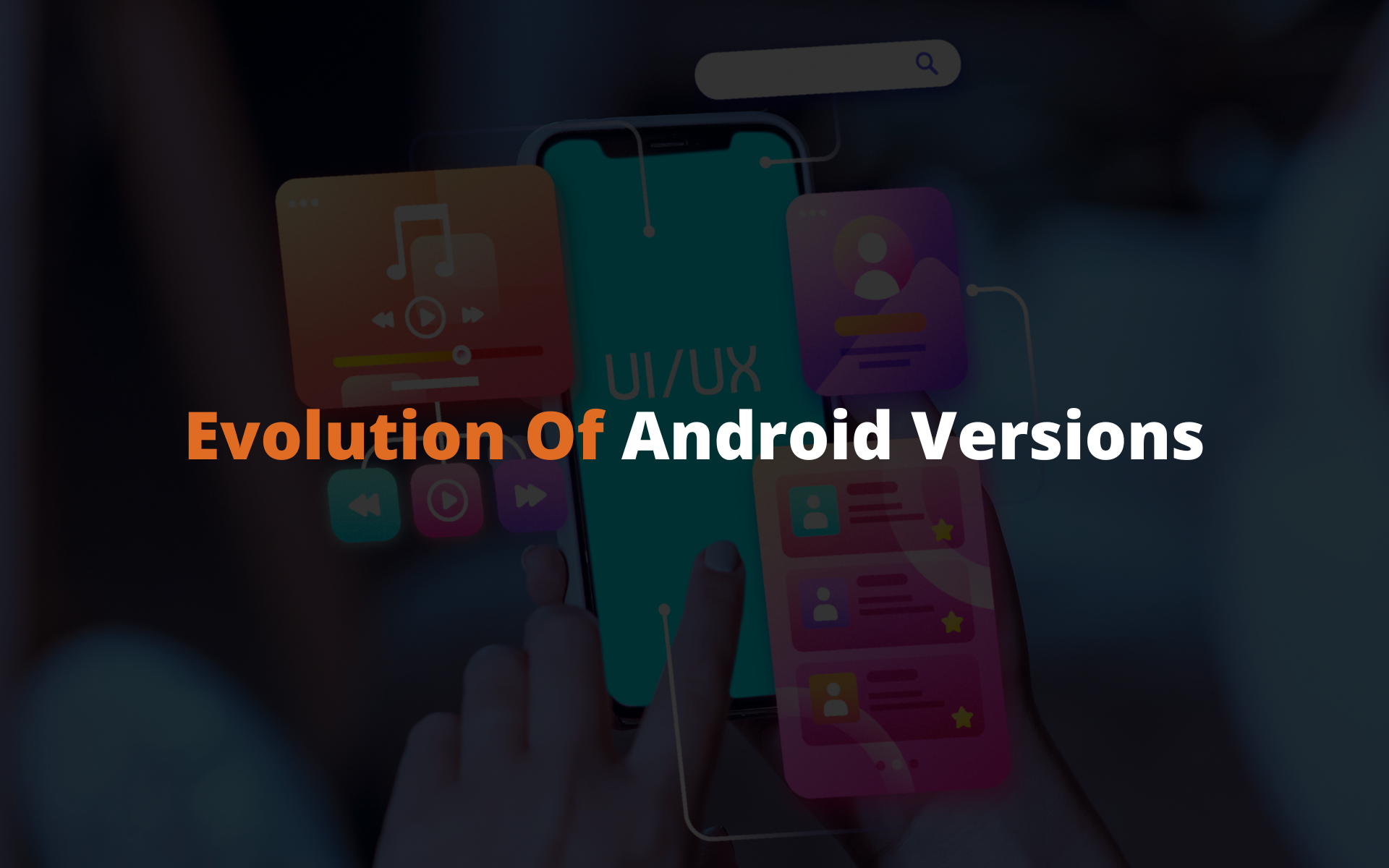Evolution Of Android Versions
Android has been a big part of our mobile world since it first came out in 2008. Back then, it started with only a few basic features like email, maps, and a browser. Over the years, it has grown into the most popular mobile operating system, powering millions of phones and tablets around the world.
Each version of Android adds something new, better design, useful tools, stronger security, and smarter ways to use our devices. From its early days to the latest updates, Android has changed the way we connect, work, and enjoy technology. In this blog, we’ll explore the journey of Android through its different versions.
Android Version List
Below is an Android version list including all major Android version names and their names to give you a clear overview of Android's evolution:
|
Android Version |
Android Version Names |
|
1.0 – 1.1 |
Alpha |
|
1.5 |
Cupcake |
|
1.6 |
Donut |
|
2.0 – 2.1 |
Eclair |
|
2.2 |
Froyo |
|
2.3 |
Gingerbread |
|
3.0 – 3.2 |
Honeycomb |
|
4 |
Ice Cream Sandwich |
|
4.1 – 4.3 |
Jelly Bean |
|
4.4 |
KitKat |
|
5.0 – 5.1 |
Lollipop |
|
6 |
Marshmallow |
|
7.0 – 7.1 |
Nougat |
|
8.0 – 8.1 |
Oreo |
|
9 |
Pie |
|
10 |
Android 10 |
|
11 |
Android 11 |
|
12 |
Android 12 |
|
13 |
Android 13 |
|
14 |
Android 14 |
|
15 |
Android 15 |
|
16 |
Android 16 |
1. Android 1.0: Alpha
On September 23, 2008, Android 1.0, the first version of the operating system, was made available. This early version had a lot of flaws, like the requirement for hardware buttons or keyboards. It has level 1 of the Android API (application programming interface).
The numeric value known as API level designates the API framework revision made available by the Android platform's version. The basic collection of classes, packages, XML elements, intents, and permissions that an application can ask for is included in the API framework.
.jpg)
Source: ChatGPT
Features of Android 1.0
- Google Maps, the browse
- The calendar
- The camera, and a scrollable notification bar with contacts,
- Gmail integration and Google Sync.
- Wi-Fi and Bluetooth are supported wirelessly.
2. Android 1.1: Beta
On February 9, 2009, Google released the Android Beta version, fixing bugs and altering the API. Only T-Mobile G1 devices received this Android update.
Features of Android 1.1
- Display location information and ratings
- Include a message attachment and save it.
- Give specific details by selecting the company
3. Android 1.5: Cupcake
On April 30, 2009, it was published with the first acknowledged public code name and incredible upgrades over the previous iterations. Additionally, it introduced the third-party app widgets, which were the most distinctive and useful feature.
Features of Android 1.5
- A search function and an on-screen keyboard.
- putting films and photographs online
- Videos and the ability to copy & paste
- assistance with MPEG4 and 3GP formats
4. Android 1.6: Donut
The ability to function on a variety of different screen sizes and resolutions was one of many useful additions in the Android 1.6 version, which was released on September 15, 2009. Donut offers voice and text entry search, bookmark history, the option to select multiple photos for deletion, and both.
Features of Android 1.6
- Power Control widget for Bluetooth, GPS, and other wireless technologies.
- Quick-toggle features for the camera and gallery
- Technology support for CDMA/EVDO, 802.1x, VPNs, and a text-to-speech engine. WVGA screen resolution, speed
- enhancements to the camera and search performance
- Instant Search Box
5. Android 2.0: Eclair
On December 3, 2009, Éclair 2.0 - 2.1 with multiple account synchronisations of email and contacts was published. Additionally, a number of additional functions, such as flash support, scene mode, white balance, colour effect, macro focus, and digital zoom, have been included.
The Éclair received bug fixes and stability enhancements in Android 2.1. Real-time traffic updates and voice-guided turn-by-turn navigation were the most useful features.
Features of Android 2.0
- Improved UI with Bluetooth 2.1
- Improve the Internet map
- Little-changed API
- Support Animated and live wallpapers
- Adding a contact's photo and choosing between calling, texting, and emailing

6. Android 2.2: Froyo
On May 20, 2010, Google announced Android version 2.2, which had performance, memory, and speed enhancements. It was released with improved Bluetooth capabilities, dock compatibility, and a portable WiFi hotspot for distributing the 3G connection.
The first smartphone running Android 2.2 was the Google Nexus One. The list of Android versions gives you an overview of all previous upgrades and enhancements to the Android operating system.
Features of Android 2.2
- Animated GIF support and multiple keyboard languages
- Increases in performance and speed
- Support for uploading files via the browser, Support for alphanumeric and numeric passwords to increase security
- Increased compatibility with headphone and vehicle kit systems
- Wi-Fi support for the hotspot feature
7. Android 2.3: Gingerbread
Gingerbread, which was made available on December 6, 2010, is listed as the seventh Android version. The release of a gaming API with improved graphics-intensive gameplay was the primary upgraded feature, which led to a surge in mobile games.
Features of Android 2.3
- Improve Support for the VP8 and WebM video formats, updated UI design Copy & Paste functionality
- Social networking and video calling are supported
- Quicker and more intuitive typing on a simple keyboard
8. Android 3.0: Honeycomb
The Honeycomb was introduced in 2011 with the release of Honeycomb, a tablet-only version of the Android operating system. It was also appropriate for older mobiles with wider screens than modern smartphones.
Features of Android 3.0
- Improvements to Gmail, contacts, camera, and gallery
- Support for complicated character passwords
- Improved 3D UI and encrypted storage
- Supports recent programmes and multiple processors for simple visual multitasking
- From an SD Card, Media Sync
- Application control action bar
- Global status and notification system bar
- Support for Google Talk video chat and eBooks, A browser with more sensor support and Adobe Flash
- Wi-Fi connections and locks with high performance
- A new keyboard, and writing in Chinese
9. Android 4.0: Ice Cream Sandwich
On October 19, 2011, the ice cream sandwich was released with a number of upgraded features to usher in the modern design period. Holding the volume and power buttons together allows you to take screenshots with the snapshot feature.
There are many different Android operating systems listed in the Android version list; however, Ice Cream Sandwich widgets are more capable and resizable than those in any previous version.
Features of Android 4.0
- The ability to spell check
- On-screen buttons and Wi-Fi direct Photo Decor functionality
- Fixing the face during unlocking
- Card-like design for toggling between apps
- Increased high-resolution video recording
- Improved camera functionality
- A web browser's ability to open up to 16 tabs
10. Android 4.1: Jelly Bean
Jelly Bean, a more advanced version of Android, had Google Digital Assistant functionality and was made available from the home screen in June 2012. The amazing predictive intelligence tool offers interactive and expandable notifications.
The multi-user support for play, as well as many other beneficial features, is also available to users.
Features of Android 4.1
- Searching by voice and typing Panorama
- Project Butter Expandable alerts
- As a screensaver, daydream
- Power management
- Support USB sound
- An enhanced camera app
- Security upgrades
- New gestures and features for accessibility
- Several user accounts (available only on tablets)
- 4K resolution assistance
- A Bluetooth low energy support
- Support for bilingual text and several languages
- Set or modify the incoming call volume, and display a message alert.
- Based on your search history, Google presents relevant information.
- Native support for emoji
11. Android 4.4: KitKat
On September 3, 2013, Android version 4.4 was released, with a greater emphasis on improving user experience. KitKat is designed to function on a wider range of older Android versions, as listed. The smartphone should have at least 512 MB of RAM.
Features of Android 4.4
- Screen capture
- Contact Order Priority
- GPS Support, Smarter Caller ID Support for Offline Music Updates to the Alarm and Google Maps User Interface
- The 'OK Google' feature in KitKat's Google keyboard lets users contact Google without having to touch their smartphones and adds cartoonish ideograms and emojis.
12. Android 5.0: Lollipop
With a new user interface and "material design" construction, Lollipop, or Android 5.0, was released on November 12, 2014. It gives all Android applications and Google products a fresh, contemporary look. The Android version list includes Lollipop, which has a ton of wonderful improvements, including support for improved notification management.
Features of Android 5.0
- Encourage ART
- Improved device security
- From the lock screen, notifications can be dismissed with a flick.
- Improved and upgraded user interface, Built-in battery saver feature
- A fresh material design
- New navigation bar
- Multiple SIM card support
- Call with high-definition voice.
13. Android 6.0: Marshmallow
Google referred to Android version 6.0 in 2015 as "Macadamia Nut Cookie" before the official release of Marshmallow.
Features of Android 6.0
- assistance with fingerprint readers
- USB Type-C support
- Sleep Mode for several windows to conserve battery life
- Clearly defined permissions
- enhanced copy-pasting and customised Google tabs
14. Android 7.0: Nougat
With a native split-screen mode, data-saving features, and a "bundled-by-app" mechanism to group notifications, Android 7.0 was introduced in 2016.
Features of Android 7.0
- Allow for split-screen and multitasking
- upgrades to the storage manager
- toggles for quick settings
- Touch screen improvements
- more effective setting application
- without opening programmes, reply to messages and notifications inline.
15. Android 8.0: Oreo
Oreo was released in the year 2017, having native picture-in-picture mode, notification snoozing options and better control over how applications can alert you by notifications.
Features of Android 8.0
- Password autofill
- Auto-enable Wi-Fi
- Downloadable fonts
- Multi-display support
- Support Picture-in-Picture
- Notification channels and snooze notification
- Google Play support and new emoji styling
- Adaptive icons and smart text selection
16. Android 9: Pie
On August 6, 2018, the pie was made available to the general public with a tonne of wonderful features tailored to the needs and interests of the users. Pie is the operating system that Android users utilise the most, according to a report.
Features of Android 9
- Sound booster with choices to shout out loud
- compatibility with artificial intelligence (AI)
- With background limits, adaptive battery and brightness
- Support for several cameras and interoperability with external cameras
- New App Actions and Gesture Navigation
- a fresh screenshot Menu for accessibility and shortcuts
- Support for edge-to-edge screens and simpler screen rotation
- improvements to the sound and volume
- a programmable dark mode
- Multiple Bluetooth connections, HDR, and HD audio
- Slices and long presses for selection overview
- New security measures for increased safety
- Digital Wellbeing includes do not disturb, dashboard, and timers for apps
17. Android 10: Android Q
On September 3, 2019, Google officially unveiled Android version 10, which has improved features and higher API levels.
Features of Android 10
- support for flexible-screen, foldable smartphones
- Dark mode for the comfort of the eyes
- ever-faster and intuitive gesture navigation control
- a sound booster that produces a clearer sound
- Intelligent reply suggestions for all messaging programmes
- Live captions for mobile media playback
- Reverse app removal
- Improved notification management with lots of choices.
18. Android 11 (Red Velvet Cake)
According to user needs, Android developers are constantly attempting to provide more sophisticated applications. The majority of developers are comparing Android Developer vs Web Developer to see which field is hot right now.
The new Android 11, which will be the most recent version in the list of Android versions, will come with the new features listed below.
- a native screen capture
- increasing touch sensitivity while notifications are muted in the video
- Historical Notifications
- Automatic app permission revocation
The upgraded or revised features are as follows:
- updated shortcuts for the menu and screenshots
- Undoing recently cleared programmes using a new text selection mode
- No longer does Aeroplane mode disable Bluetooth.
- In the Pixel 4, Face Unlock requires you to open your eyes.
- Pinnable apps in the sharing menu
- Enhancements to notification conversation shades
- Context-aware dark mode and conversation bubbles
- Enhancements to one-time permissions
19. Android 12 Snow Cone
On October 4th, Android 12 was formally announced, and on October 19th, it began rolling out to Pixel smartphones that were compatible. After that, a number of manufacturers followed suit and began sending out the stable Android 12 upgrade to their premium handsets, including the OnePlus 9 series and the Samsung Galaxy S21 series. The update rollout roadmaps for each OEM's device have also been made public.
Android 12 is more exciting than the previous iterations of the operating system because most advancements are mostly surface-level. 'Material you' is the name of a new standard that is included in the upgrade.
The information you provide gives the Android experience an entirely new appearance and feel that is not just restricted to system-level components.
Features of Android 12
- Redesigned quick settings and notifications
- markers for the camera and microphone
- game console
- alterations to widgets
- privacy display
- screenshots that scroll
20. Android 13 Tiramisu
Android 13 has been officially released by Google to the AOSP (Android Open Source Project), and Google Pixel smartphones have begun receiving the Android 13 stable update as of August 15. Android 13 is the follow-up to Android 12, which featured the new Material You design language and one of the biggest design updates the OS has seen since Android 5.0.
According to the business, Android 13 will be made available "later this year" for devices made by Samsung, Asus, HMD (Nokia phones), iQOO, Motorola, OnePlus, Oppo, Realme, Sharp, Sony, Tecno, Vivo, and more.
Features of Android 13
- New icon themes for the photo picker app
- Enhancing individual app language preferences
- New modules for Project Mainline
- Audio using Bluetooth LE
- Enhanced command over app notifications
- Downgradable rights for developers
- An enhanced text support
21. Android 14 (Upside Down Cake)
Android 14 was released on October 4, 2023, and launched alongside the Pixel 8 series. It continued refining Android’s customisation and performance focus while also tightening security by restricting apps targeting old APIs.
Features of Android 14
- Customisable lock screen and wallpapers
- Improved battery life and performance optimization
- Blocked app installs targeting Android 6.0 or below
- Regional preferences (e.g., units, calendar)
- Enhanced accessibility (font scaling to 200%)
- Satellite communication support (early stages)
- Improved large screen and foldable support
22. Android 15 (Vanilla Ice Cream)
Android 15 was released on September 3, 2024, with stable rollout starting in October for Pixel devices. It expanded Android’s multitasking abilities and introduced privacy-forward features like Private Space to hide sensitive apps.
Features of Android 15
- Private Space for secure app storage
- Enhanced split-screen multitasking for tablets
- Theft Detection Lock for lost/stolen device protection
- Satellite messaging API support
- Predictive back gesture with animation preview
- New volume panel UI
- Improved vibration controls and haptics
- Additional security & background task restrictions
23. Android 16 (Baklava)
As of June 2025, Android 16 is in beta, with a stable release expected soon. Codenamed "Baklava," it continues Google’s push for privacy, security, and large-screen usability, while further expanding AI integration and system intelligence.
Features of Android 16
- Expanded Private Space capabilities
- Deeper AI integration across UI elements
- Smarter battery optimization for background apps
- More refined gesture navigation
- Enhanced widget interactivity
- Improved satellite messaging UI
- Stricter background task management
Conclusion
The story of Android is about how our phones have become smarter and more helpful over time. The first version came out in 2008 with only a few simple apps. Today, the latest version is called “Baklava,” and Android has grown a lot since then.
Each new version has added useful changes, better design, faster speed, stronger security, and new ways to use our devices. Features like split-screen multitasking, fingerprint unlock, dark mode, AI tools, and privacy settings have made Android the world’s most popular mobile system.
Now, Android is not just for phones. It also powers tablets, foldable devices, and more. With every update, it keeps getting better, making daily life easier, safer, and more connected. And if you want to build powerful Android apps that match this growth, WOWinfotech helps you with expert app development services.
FAQ
-

Krishna Handge
WOWinfotech
Sep 11,2025
